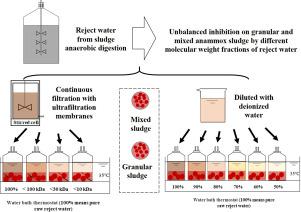Journal of Water Process Engineering ( IF 7 ) Pub Date : 2021-07-07 , DOI: 10.1016/j.jwpe.2021.102197 Shunyu Wang 1, 2 , Hui Gong 2 , Jianning Ding 1, 2 , Enhui Xu 2 , Rongrong Cui 1, 2 , Dianhai Yang 2 , Guowei Gu 2 , Xiaohu Dai 2

|
Anaerobic ammonium oxidation (anammox) was a sustainable low-cost method to deal with high ammonia wastewater. Unbiodegradable proportion of sludge anaerobic digestion reject water demonstrated unbalanced inhibitory effects on specific anammox activity (SAA). The SAA of 0.155 gN·gVSS−1·d−1 (based on ammonia) was obtained with 50% raw pretreated reject water proportion. In contrast, SAA decreased to 0.061 gN·gVSS−1·d−1 with 100% raw pretreated reject water without dilution, about 60.65% of that at half dilution ratio. Comparing the SAA of granular and mixed anammox sludge, granular sludge demonstrated more resilience than mixed anammox with higher abundance at same sludge concentration. Unbalanced inhibition by different molecular weight fractions of reject water was observed. The SAA tests shown that the organics between 10 kDa and 30 kDa caused more severe inhibition on anammox activity, though the organic concentration in this molecular weight cut-off (MWCO) range was only accounted for limited proportion. Besides, the results of three-dimension excitation emission matrix fluorescence spectroscopy (EEM) and Fourier transform infrared spectra (FTIR) analysis demonstrated the existence of fulvic acid-like substances, tryptophan-like protein substances, carboxylic acid and derivatives and small amide groups in this MWCO range of unbiodegradable sludge digestion reject water.
中文翻译:

污泥厌氧消化废水中不同分子量分数对颗粒和混合厌氧污泥的不平衡抑制
厌氧氨氧化(anammox)是一种可持续的低成本处理高氨废水的方法。不可生物降解比例的污泥厌氧消化废水表现出对特定厌氧氨氧化活性(SAA)的不平衡抑制作用。0.155 gN·gVSS -1 ·d -1(基于氨)的SAA是用50% 的原始预处理废水比例获得的。相比之下,SAA 降至 0.061 gN·gVSS -1 ·d -1100%未经稀释的未经处理的原水,大约是半稀释比的60.65%。比较颗粒污泥和混合厌氧氨氧化污泥的 SAA,在相同污泥浓度下,颗粒污泥比具有更高丰度的混合厌氧氨氧化污泥表现出更大的弹性。观察到废水的不同分子量部分的不平衡抑制。SAA 测试表明,10 kDa 和 30 kDa 之间的有机物对厌氧氨氧化活性产生更严重的抑制,尽管该分子量截断 (MWCO) 范围内的有机物浓度仅占有限的比例。此外,三维激发发射矩阵荧光光谱(EEM)和傅里叶变换红外光谱(FTIR)分析结果表明存在富里酸样物质、色氨酸样蛋白质物质、


























 京公网安备 11010802027423号
京公网安备 11010802027423号